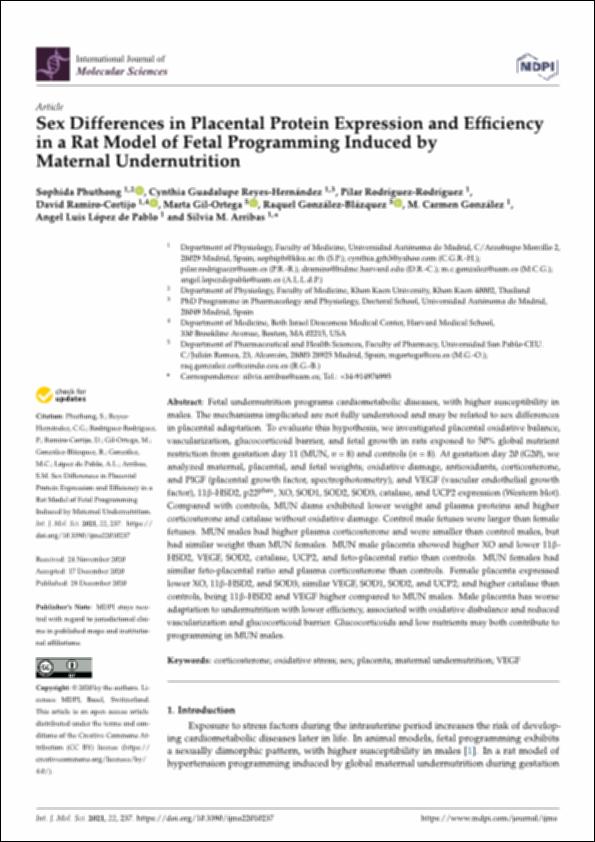Por favor, use este identificador para citar o enlazar este ítem:
http://hdl.handle.net/10637/14606Sex Differences in Placental Protein Expression and Efficiency in a Rat Model of Fetal Programming Induced by Maternal Undernutrition
| Título : | Sex Differences in Placental Protein Expression and Efficiency in a Rat Model of Fetal Programming Induced by Maternal Undernutrition |
| Autor : | González Blázquez, Raquel Gil Ortega, Marta Phuthong, Sophida Reyes-Hernández, Cynthia Guadalupe Rodríguez-Rodríguez, Pilar Ramiro-Cortijo, David González, María del Carmen López de Pablo León, Ángel Luis Arribas Rodríguez, Silvia Magdalena |
| Materias: | Corticosterone; Oxidative stress; Placenta |
| Editorial : | MDPI |
| Citación : | Phuthong, S.; Reyes- Hernández, C.G.; Rodríguez-Rodríguez, P.; Ramiro-Cortijo, D.; Gil-Ortega, M.; González-Blázquez, R.; González, M.C.; López de Pablo, A.L.; Arribas, S.M. Sex Differences in Placental Protein Expression and Efficiency in a Rat Model of Fetal Programming Induced by Maternal Undernutrition. Int. J. Mol. Sci. 2021, 22, 237. https:// doi.org/10.3390/ijms22010237 |
| Resumen : | Fetal undernutrition programs cardiometabolic diseases, with higher susceptibility in males. The mechanisms implicated are not fully understood and may be related to sex differences in placental adaptation. To evaluate this hypothesis, we investigated placental oxidative balance, vascularization, glucocorticoid barrier, and fetal growth in rats exposed to 50% global nutrient restriction from gestation day 11 (MUN, n = 8) and controls (n = 8). At gestation day 20 (G20), we analyzed maternal, placental, and fetal weights; oxidative damage, antioxidants, corticosterone, and PlGF (placental growth factor, spectrophotometry); and VEGF (vascular endothelial growth factor), 11 -HSD2, p22phox, XO, SOD1, SOD2, SOD3, catalase, and UCP2 expression (Western blot). Compared with controls, MUN dams exhibited lower weight and plasma proteins and higher corticosterone and catalase without oxidative damage. Control male fetuses were larger than female fetuses. MUN males had higher plasma corticosterone and were smaller than control males, but had similar weight than MUN females. MUN male placenta showed higher XO and lower 11 - HSD2, VEGF, SOD2, catalase, UCP2, and feto-placental ratio than controls. MUN females had similar feto-placental ratio and plasma corticosterone than controls. Female placenta expressed lower XO, 11 -HSD2, and SOD3; similar VEGF, SOD1, SOD2, and UCP2; and higher catalase than controls, being 11 -HSD2 and VEGF higher compared to MUN males. Male placenta has worse adaptation to undernutrition with lower efficiency, associated with oxidative disbalance and reduced vascularization and glucocorticoid barrier. Glucocorticoids and low nutrients may both contribute to programming in MUN males. |
| URI : | http://hdl.handle.net/10637/14606 |
| Derechos: | http://creativecommons.org/licenses/by-nc-nd/4.0/deed.es |
| ISSN : | 1422-0067 |
| Fecha de publicación : | 28-dic-2020 |
| Centro : | Universidad San Pablo-CEU |
| Aparece en las colecciones: | Facultad de Farmacia |
Los ítems de DSpace están protegidos por copyright, con todos los derechos reservados, a menos que se indique lo contrario.


